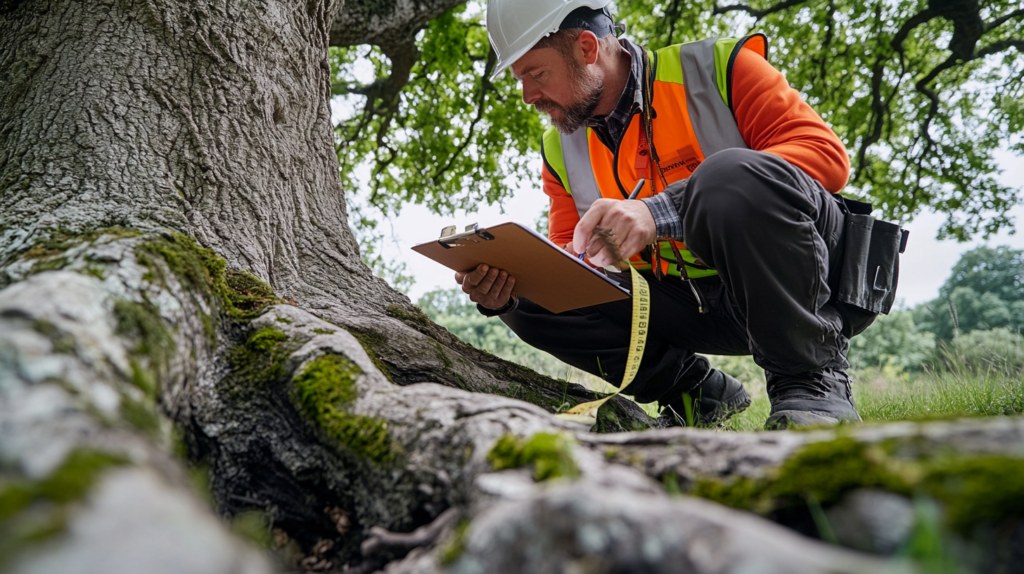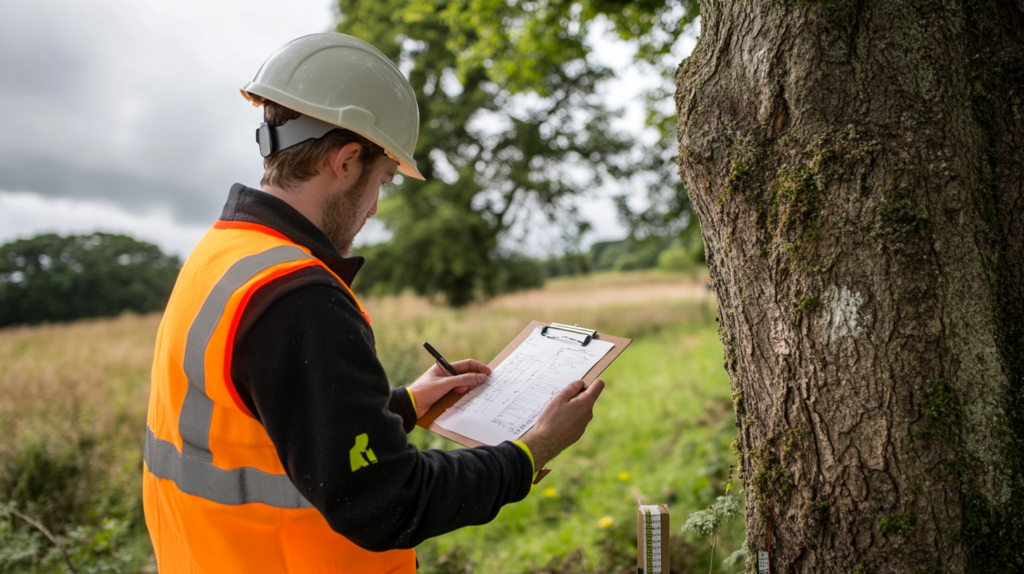
The Architect’s Guide to Planning Application Tree Reports
Why Tree Surveys Matter: Unlocking Planning Success Without Delays
You’ve got a project lined up. The design is solid. The client is on board. Planning approval should be a breeze, right? Then comes the curveball—tree surveys.
Local planning authorities won’t approve your project without one if trees are present. Ignore it, and you risk costly delays, objections, or outright rejection.
Tree surveys for planning applications aren’t just a box-ticking exercise. They directly impact site layout, foundation design, and even the viability of your entire project. Get it right early, and you avoid time-consuming redesigns. Get it wrong, and your plans could be stopped in their tracks.
Planners expect detailed arboricultural assessments that show how development impacts existing trees. That means understanding tree constraints, root protection areas, and mitigation measures before submitting your application.
A well-prepared tree survey does more than satisfy planning conditions. It helps you optimise site usage, avoid legal headaches, and keep your project on schedule.
Key Tree Survey Types: Which One Do You Actually Need?
Not all tree surveys are the same. The type you need depends on your project stage, the trees on-site, and what the local planning authority requires.
Here’s the breakdown:
- Tree Constraints Plan (TCP) – Identifies trees that may affect the layout. Helps you design around them from the start. Essential for avoiding planning objections.
- Arboricultural Impact Assessment (AIA) – Evaluates how your development affects existing trees. Required for most planning applications. Helps planners assess risks and mitigation strategies.
- Tree Protection Plan (TPP) – Outlines protective measures for retained trees. Crucial for ensuring compliance with BS5837 and avoiding enforcement actions.
- Arboricultural Method Statement (AMS) – Specifies how works will be carried out near trees without causing damage. Often required for planning conditions.
- BS5837 Tree Survey – The foundation of all planning-related tree surveys. Categorises trees by quality and retention value. Planners use it to determine which trees can be removed and which must be protected.
Choosing the right survey early prevents unnecessary back-and-forth with planning officers. It also gives you clarity on what’s possible within site constraints.
BS5837 Explained: The Gold Standard for Tree Surveys in Development
BS5837 is the industry standard for tree surveys in planning. It’s the benchmark used by local authorities to assess development proposals involving trees.
This survey categorises trees into four groups:
- Category A (High Quality) – Trees with significant value. Removal is rarely permitted.
- Category B (Moderate Quality) – Trees worth retaining, but not as critical as Category A.
- Category C (Low Quality) – Trees of limited value. Often approved for removal.
- Category U (Unsuitable for Retention) – Dead, dying, or dangerous trees. Usually recommended for removal.
Understanding these categories helps you plan effectively. High-quality trees will dictate site layout. Low-quality trees offer flexibility for development.
BS5837 surveys also define Root Protection Areas (RPAs)—the zones where construction must be restricted to avoid harming tree roots. Miscalculate this, and your project could be stalled by objections or rejected outright.
Local planning authorities expect BS5837 compliance. If your tree survey doesn’t meet this standard, your application won’t pass.
Tree surveys for planning are more than just paperwork. They are a strategic tool for architects and planning consultants to navigate constraints, optimise designs, and secure approvals without unnecessary delays.
How to Ace Tree Survey Requirements and Avoid Planning Rejections

Tree Constraints Plans: Spot Risks Before They Derail Your Project
A tree constraints plan is your blueprint for avoiding planning nightmares. It maps out existing trees on-site, detailing their species, condition, and—most importantly—their constraints on development.
Planners scrutinise these plans to assess how trees impact your site layout. Get it wrong, and you could be forced into costly redesigns or outright refusals. Get it right, and you’ll streamline approvals while minimising unnecessary delays.
The first step is understanding what a tree constraints plan includes. Expect to see:
- Root Protection Areas (RPAs) – The invisible no-go zones around trees that dictate where you can and can’t build.
- Tree Categories (BS5837 Classification) – Trees are categorised from A (high value) to U (unsuitable for retention). This determines whether they should be preserved, relocated, or removed.
- Canopy Spreads – The horizontal reach of trees, which affects building placement and potential overshadowing issues.
When reviewing a tree constraints plan, planners want to see evidence that trees have been considered from the outset. They’ll be looking for intelligent site layouts that work with existing trees, not against them.
The earlier you commission a tree constraints plan, the better. Architects who integrate this into the initial design phase avoid expensive surprises later. If trees are an afterthought, expect resistance from planners and possible objections from local tree officers.
To maximise efficiency, work closely with an arboricultural consultant. They’ll interpret the survey results and advise on design adaptations that meet planning policy while optimising your site’s potential.
Root Protection Areas: The Critical Factor Planners Scrutinise
Root Protection Areas (RPAs) are non-negotiable. These zones safeguard a tree’s underground structure, preventing disturbance that could compromise its stability or long-term health.
Planners take RPAs seriously because damage to tree roots is often irreversible. If your development encroaches on these areas without proper mitigation, expect objections.
The formula for calculating an RPA is standardised under BS5837:
- Measure the tree’s stem diameter at 1.5m height.
- Multiply by 12 to determine the RPA radius.
- The result is a circular protection zone, unless site constraints dictate otherwise.
In practice, RPAs can be adjusted slightly in shape but not in total area. If development pressure is unavoidable, you may need specialist mitigation measures like:
- No-Dig Foundations – These allow construction within RPAs without disturbing roots.
- Root Bridging Systems – Elevated structures that protect underlying soil.
- Air Spade Investigations – Used to locate and map critical roots before designing around them.
Ignoring RPAs is a fast track to planning rejection. Instead, use them to guide your site layout from day one. Work with an arboricultural consultant to explore design solutions that balance development needs with tree protection.
Planners will expect to see a Tree Protection Plan that outlines how RPAs will be safeguarded during construction. This should be submitted alongside your planning application to demonstrate due diligence.
Arboricultural Impact Assessments: How to Get Your Report Right First Time
An Arboricultural Impact Assessment (AIA) is the litmus test for whether your development considers tree constraints effectively. It goes beyond a tree constraints plan by analysing the actual impact of your proposals on existing trees.
This report is a requirement for most planning applications where trees are present. It assesses:
- The direct impact of construction (e.g., tree removals, changes to ground levels).
- The indirect impact on retained trees (e.g., altered drainage, proximity to structures).
- The mitigation measures proposed to offset negative effects.
AIAs must align with BS5837 guidelines and be prepared by a qualified arboricultural consultant. A weak report that fails to justify tree removals or lacks credible mitigation strategies can lead to planning refusals.
Common AIA mistakes that trigger objections:
- Underestimating tree value – Misclassifying trees can lead to backlash from local authorities.
- Ignoring cumulative impacts – Small changes add up. Planners want a holistic view of how trees and development interact.
- Vague mitigation proposals – If you’re proposing tree protection measures, they must be precise, enforceable, and backed by industry standards.
A well-prepared AIA strengthens your planning application by demonstrating compliance with tree protection policies. It reassures planners that your development respects the existing tree stock while integrating necessary safeguards.
For architects and planning consultants, understanding how tree surveys for planning influence decision-making is a strategic advantage. By proactively addressing tree constraints, Root Protection Areas, and arboricultural impact assessments, you’ll navigate planning regulations with confidence.
For a complete guide to tree surveys and ensuring planning success, take a look at our content hub on Linkeding by clicking this link HERE.
Streamlining the Tree Survey Process for Faster Planning Approval
When to Commission a Tree Survey: The Best Timing for Seamless Approvals
Timing is everything. Get this wrong, and you could be facing costly delays, redesigns, or outright refusals. Get it right, and your planning application moves forward without a hitch.
You need a tree survey before submitting a planning application if your site has existing trees—whether inside or just outside the boundary. Local planning authorities (LPAs) scrutinise how trees will be affected by development. If you fail to provide a tree survey early, planners will request one, potentially stalling your project for weeks or months.
The ideal time to commission a BS5837 tree survey is at the pre-application stage. This allows you to integrate tree data into site plans before submitting them to the LPA. You’ll identify constraints early, adjust layouts accordingly, and avoid the dreaded “further information required” notice that can derail your timeline.
For architects and planning consultants, this is a strategic move. By addressing tree constraints upfront, you reduce the risk of objections from tree officers and conservation teams. You also demonstrate a proactive approach to responsible development, which can strengthen your case for approval.
Seasonality matters too. While tree surveys can be conducted year-round, certain species may be harder to identify outside of leafing season. If your site includes deciduous trees, aim for a survey in late spring or summer when foliage is fully developed.
Working with an Arboricultural Consultant: What to Expect and How to Maximise Value
Choosing the right arboricultural consultant can make or break your planning application. The best consultants don’t just tick a box for compliance—they provide strategic insights that help you navigate tree-related planning constraints efficiently.
Expect a site visit where the arboricultural consultant assesses tree species, health, dimensions, and positioning. This data is used to produce a tree survey report and, if required, a tree constraints plan. These documents map out trees on-site, categorise their retention value, and highlight their impact on your proposed development.
For maximum value, involve your arboricultural consultant before finalising site layouts. Too often, architects design a scheme only to discover that key trees need to be retained, forcing a costly redesign. A good consultant will help you work around constraints from the outset, ensuring your design is both viable and compliant.
If trees are close to proposed structures, you may need additional reports such as an Arboricultural Impact Assessment (AIA) or a Tree Protection Plan (TPP). These documents demonstrate how trees will be preserved during and after construction, preventing objections from planners.
Communication is key. Ensure your consultant works closely with your design team. They should provide clear, actionable advice on tree constraints, root protection areas, and mitigation strategies. This collaboration avoids conflicts between tree retention and development objectives, keeping your project on track.
Common Planning Pitfalls: How to Use Tree Surveys to Overcome Objections
Tree-related objections are a leading cause of planning delays. LPAs prioritise tree protection, and if your application conflicts with local tree policies, expect resistance. However, with the right approach, you can navigate these challenges effectively.
One major pitfall is underestimating root protection areas (RPAs). RPAs define the minimum space needed to safeguard a tree’s root system. If your design encroaches on this zone without mitigation, planners will push back. The solution? Incorporate RPAs into early-stage plans. Use specialist foundations like pile and beam designs or no-dig solutions for driveways to minimise root disturbance.
Another common mistake is ignoring Tree Preservation Orders (TPOs) and Conservation Areas. Trees protected under a TPO or located within a Conservation Area require formal consent for works, including pruning or removal. Failing to check these designations can halt your project. Always verify tree protections early and, if necessary, submit a separate tree works application alongside your planning submission.
Developers often overlook tree shading impacts. If retained trees cast excessive shade on proposed dwellings or gardens, planners may raise concerns about future pressures for tree removal. You can counter this by demonstrating how your design maximises natural light while accommodating important trees.
Engaging with the LPA’s tree officer early can also prevent objections. A pre-application consultation allows you to discuss tree-related constraints proactively, showing planners that you are committed to sustainable development. This can smooth the approval process and reduce the risk of last-minute surprises.
Tree surveys are not just a compliance exercise—they are a strategic tool for securing planning permission smoothly. By commissioning surveys at the right time, working with expert arboricultural consultants, and anticipating potential objections, you can streamline your application and move forward with confidence.For more expert guidance on tree surveys for planning applications, visit our tree consultancy services.
